Arrangement of a cesspool: rules of organization and waterproofing
The lack of a centralized sewage system becomes the reason for the installation of all kinds of local treatment facilities in suburban areas. But sometimes, instead of an expensive autonomous structure, installing a simple cesspool is enough. Moreover, to cope with its construction is quite possible on their own.
In the article, we displayed detailed information on how to complete the arrangement of a cesspool on a site, what rules and norms should be followed when organizing a drainage structure. We described the most popular and practical solutions, and also provided step-by-step instructions for their implementation.
The content of the article:
Types of modern cesspools
Today, the functional load of the drain pit has increased markedly, since the presence of a home sewage system and an elementary cold water supply system increases the volume of drains several times.
In this regard, new modifications of sewage systems appeared, more voluminous and improved in terms of waste processing.
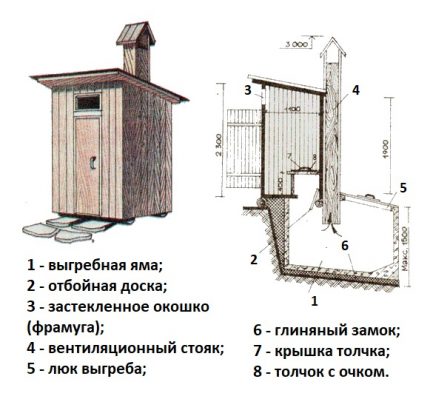
Remember how the drain pit looked like - a small well into which all the waste was methodically poured until it was completely filled. The walls of the well were lined with boards, laid out with stones or reinforced with other improvised material. When the level of wastewater became maximum - they called up a cesspool machine for pumping.
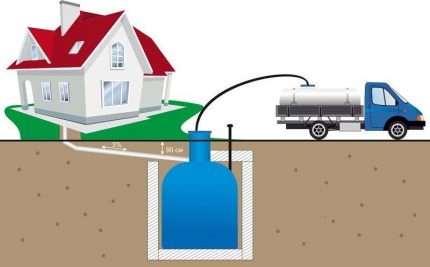
Of course, there was no talk of any ecology or protection of the environment from pollution in those days.But today everyone wants to keep the soil clean on the site, so they strictly monitor the sealing of treatment facilities.
Manufacturers choose materials that do not require a long installation or special waterproofing. Volumetric polymer tanks serve as an example of modern models.
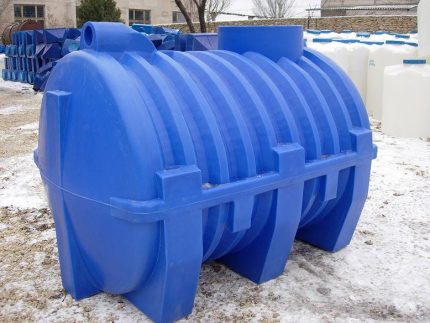
Monolithic one- and two-section concrete structures, as well as installations of one, two or even three concrete wells, have not lost popularity. The choice is explained by the relative ease of installation (pouring) and a decent (up to 30 years) service life.
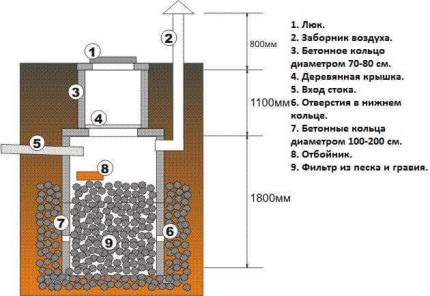
The sense of laying a mine with a brick disappeared, because installing several rings is much easier than creating solid brickwork. The main quality of new devices is tightness, which protects the soil from pollution by effluents.
Selection of a place taking into account sanitary standards
When constructing a new cesspool, one should be guided by the requirements set forth in SNiP. Of course, for ease of use, I would like to place it closer to home.
However, the distance from the foundation to the tank should be at least 10 m. Force majeure circumstances associated with a violation of the tightness of the foundation and the storage tank are taken into account.

When planning, also note that the fence outlining the boundaries of the site should be at a distance of no closer than 4 m, and the carriageway should be no closer than 5 m.
The largest interval - to the source of water (well or well) - at least 25 m, with loose sandy soil - up to 50 m. If there is a body of water with standing water (pond or lake) nearby, then it must be taken into account - 30 m.
Concrete rings - current type of material
Reinforced concrete rings for septic tanks and the construction of drinking wells is so in demand that many plants began to specialize in their production.
Moreover, in addition to the main parts, they make rings equipped with a bottom, individual necks, ceilings and upper segments with a hatch. Consider two options for the construction of cesspools, with and without bottom.
Concrete absorption well
An open tank without a bottom, in other words, an absorbing well, is a combined version resembling a conventional storage tank, but acting on the principle of a filtering element of a septic tank.
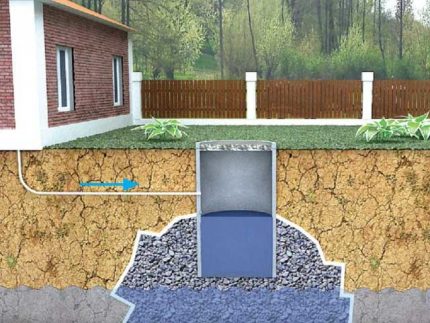
There are conditions under which the construction of an “open” bottom structure should be avoided:
- the groundwater level must be at least 100 cm below the base of the sewer well, otherwise the waste fluid will mix with the underground water horizons, which will cause soil contamination with harmful substances;
- the type of soil must meet the requirements of filtration, that is, it must be permeable: sandy, gravel or pebble with a high sand content. Rock, loam and clay do not have similar properties and over time can become an insurmountable barrier to runoff.
Subject to the conditions, you can build a well yourself.
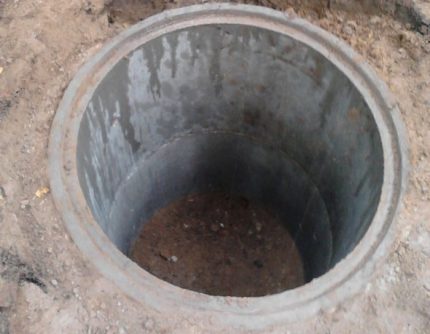
Work order:
- Digging a pit to a depth equal to the total height of the rings (2 or 3) plus half a meter for the drainage layer and 20-30 cm for arranging the neck.
- Laying the filter base from bulk materials - sand, pebbles, gravel, gravel. For example, the lower layer is sand, the upper layer is large gravel. For cleaning efficiency, a perforated concrete base or geotextile can be used.
- Ring mounting using a crane.
- Sewer connection into a hole previously made by a puncher;
- Well waterproofing - sealing joints, joints, joints;
- backfilling and tamping the soil around the perimeter of the pit.
Particular attention should be paid. cesspool waterproofing. Fixation of the pipe is best done using a tee, followed by sealing all joints with sealant.

Even when using concrete rings with a lock connection, they must be sealed from the inside and outside. From the outside, you can use glued bitumen roll material, which is laid in several layers, from the inside - a combination Penetron and Penecritus or cement mortar Aquabarrier.
To ensure the pumping process, in the upper part it is necessary to equip the hatch with a tightly closed, insulated lid.
Storage tank of rings
A high level of groundwater (a fairly common occurrence) does not allow the installation of sewer wells without a bottom, so a simple storage tank would be the most successful option. You can use a plastic tank or a large polymer barrel, but we will consider a project of concrete rings.
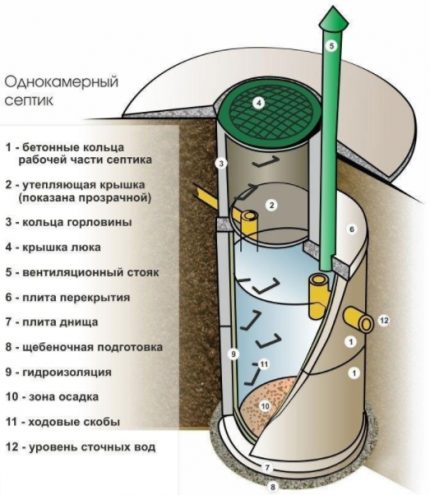
Conveniently, almost all parts can be purchased ready-made. The cost of one well ring with a diameter of 110 cm (wall thickness - 16 cm, height - 89 cm) - from 1,500 to 2,000 rubles., 6-centimeter extension - 250-300 rubles. etc., therefore, the entire structure in an amount not exceeding 10,000 rubles.
If you want to save a budget, you can make reinforced concrete rings yourself.
Progress:
- Pit device (50-80 cm wider than the well) with the simultaneous laying of trenches for sewer pipes.
- Installation and insulation the pipeline.
- Backfill and ramming sand and gravel pillows (30-40 cm in thickness).
- Installation of concrete bottom (strictly horizontal, with level checking); instead of the finished element, you can build a reinforced screed.
- Installation of concrete rings using a crane.
- Joint waterproofing rubber tape, concrete solution with the addition of liquid glass.
- Coating internal seams bituminous mastic, external - pasting bituminous waterproofing. Backfilling.
- Top plate mounting with a hole for the hatch, fixing the cover.
One of the products of bacterial waste processing is the hazardous gas methane. To prevent its concentration, and at the same time provide air access to drains, the well is equipped with a ventilation pipe.
Using concrete rings, you can build a two-chamber septic tank, more in this article.
Budget option from rubber tires
The advantages of this project are accessibility, profitability, ease of installation, and the minuses are fragility, lack of good sealing, and “one-time” design. It is impossible to repair or modify the installed structure.
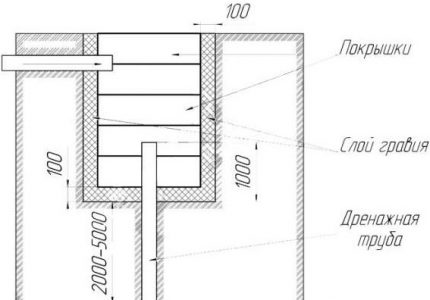
The first step is excavation and pit construction. The depth can be calculated by knowing the number of tires, the width - by putting one product on the ground and drawing a circle around it, adding 30-40 cm. When the pit is ready, it is necessary to make a drainage hole. It is drilled in the center of the pit using a drill.
A pipe is inserted into the hole so that it rises above the base by about 100-120 cm. A meter supply prevents the drainage from clogging with large solid particles that accumulate at the bottom.
In order for the liquid to freely enter the drain, its sides are additionally perforated, and the upper end is covered with a protective net. The bottom around the pipe is covered with gravel or gravel.

Tires are stacked one on top of the other, smearing the joints with sealant. In about 2 or 3 tires, a hole is cut from above and the end of the sewer pipe leading from the house is inserted, the connection point is also carefully sealed.
From above, the structure is closed with a homemade lid made of plastic or wood with a small cutout (diameter = 10 cm) for the ventilation pipe.
Additional information on the appropriateness of such a decision, the selection and preparation of tires, as well as the construction of a cesspool from them, is presented in the article - DIY drain pit from tires: step-by-step instructions for arranging
Installing a plastic container
Main plus mounting a polymer tank - lack of additional construction activities. It is enough to dig a pit, attach sewer lines, bury - and the cesspool is ready. Transporting a plastic container is also not difficult, because, unlike concrete structures, it has a small weight.
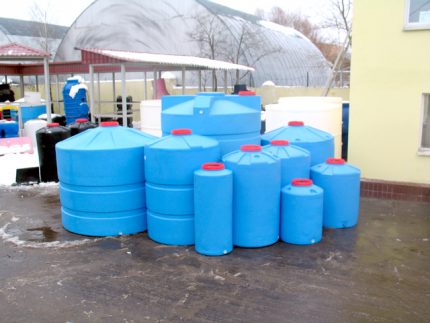
A metal barrel is also suitable, but it is inferior to plastic containers in its characteristics, since it is susceptible to corrosion, therefore, it rusts quickly enough and will fail.
Before installing in the pit, the container must be prepared - perforation over the entire surface is made. To do this, we drill holes in a checkerboard pattern with an electric drill, the interval between the holes is 15-20 cm. Perforation is necessary for the device to naturally drain the liquid, this is a kind of filter.
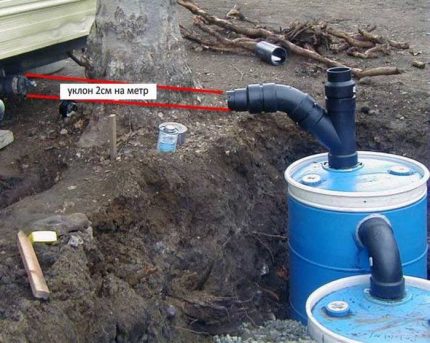
In the upper part or side (depending on the supply of the sewer pipe) we cut a hole and install a flange. We carefully coat all joints and joints with special polymer sealants.
You can use bitumen mastic, which plays the role of additional waterproofing. It is desirable that the pipes and fittings were also made of plastic.
To protect the tank from particles of soil, we use geotextiles. It copes well with the filtering function, does not lend itself to decay and rapid wear. We wrap the reservoir on all sides with rolled geotextiles, fix it at the neck with a synthetic cord.
We install the barrel in the prepared foundation pit, attach it to the communications. The slope of the pipes allows the drains to flow naturally into the tank. We fill the free space on the sides with a sand and gravel mixture, sprinkle with soil on top. Cleaning the mini-septic tank must be carried out, focusing on the degree of filling.
The process of installing a storage tank for the complete pumping of effluents looks somewhat different. It involves immersion in the soil of an absolutely sealed container, which is used to accumulate brown and mixed masses.
In the process of accumulation, equal to approximately one third of the volume, they are called up as a waste collector to empty the drive.
Construction of a pit of cast concrete
Ready-made containers are not always suitable in shape or size, besides, the cost of high-quality volumetric septic tanks does not suit everyone, therefore they still practice such a method of constructing a cesspool as building a monolithic one- or two-chamber concrete tank. We will get acquainted with the instructions for its manufacture.
How to dig a foundation pit
During construction, you can not be limited to a single-chamber structure, since there will be no fundamental difference or additional complexity during the construction of the second compartment. We'll have to dig a pit twice as large and prepare more building material for formwork and pouring.
The first compartment of the septic tank is intended for clarification of drains, the second - for filtration.
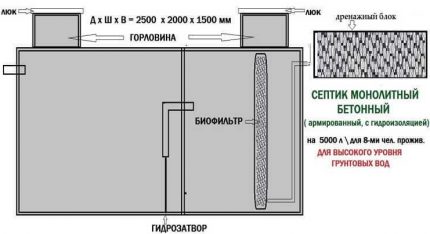
The first stage is digging a foundation pit of the required size. There are two options for excavating - manually or using construction equipment. The first method is long, but more accurate, the second is fast, but costly and not quite suitable for subsequent formwork.
The fact is that to support wooden shields, even the edges of the pit are necessary. If the soil is sufficiently solid, stable, then the formwork structure can be made one-sided.
The second chamber of the septic tank is filtering, therefore, the part of the pit must be deepened and equipped with a sand and gravel pad about 30 cm thick. The walls should be leveled, but if the soil is loose, you will have to build a two-sided structure, like a foundation.
The construction of wooden formwork
So that the underground moist environment minimally affects the concrete structure, before installing the formwork, the pit is covered with rolled geotextiles. We place the canvas so that the fluid movement is directed towards the soil. Separate pieces need to be fastened together, and the edges should protrude outward by about 40 cm.
From the outside we mount a metal frame: steel bars, thick wire, mesh from old beds are suitable for reinforcement. Metal parts can be replaced with fiberglass. When filling, it is necessary to ensure that the solution completely covers the iron elements, otherwise corrosion will cause cracking.
The panels and boards themselves will not hold, therefore, to fix them, spacers should be constructed from bars or metal sections. In places where pipes adjoin, mortgages must be made in advance.
The distance from the formwork to the pit wall is about 20-25 cm (future wall thickness of the septic tank) If the structure is double-sided, then this distance is maintained between the two walls around the entire perimeter.
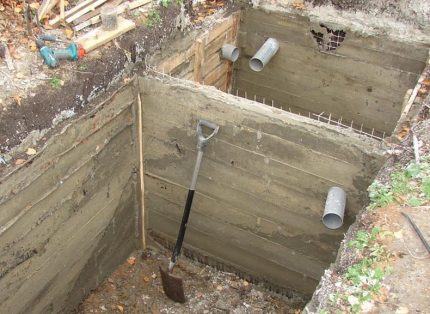
Concrete pouring and waterproofing
We prepare the solution according to the following scheme: for every 200 kg of cement - 300 kg of sand, 100 l of water, 2.5 l of superplasticizer (in liquid form). If a filler is needed, add a small amount of crushed stone of a small fraction.
Concrete is never poured over the entire volume. If you want the structure to be durable and last for years, fill it with layers, each of which is not thicker than 40-50 cm. Otherwise, voids will form in the material, which will cause rapid destruction of the structure. To make the mass denser, use a vibrator.
Experts recommend equipping the overflow with a tee, which will reduce the risk of clogging and prevent large particles from entering the second filter compartment.
During the solidification of the concrete mass, small cracks will appear, which must be covered with the same solution. After complete drying, you can increase the tightness of the chambers and make additional internal waterproofing.
The last stage of concreting is the device of the upper floor. It is installed after the walls have completely dried (a period of 10 days to 2 weeks is required).
Procedure:
- installation of a metal profile - corners;
- laying the base - flat slate or wooden boards;
- ruberoid flooring followed by reinforcement;
- concrete pouring.
Do not forget that you need 2 holes for the hatches (according to the number of cameras).
Backfill and exterior design
Before backfilling, we make waterproofing - we apply on all concrete surfaces, internal and external, a layer of bitumen mastic. It will protect concrete from moisture and rapid destruction.
In the northern regions, additional thermal insulation is needed. To insulate the chambers from the outer sides along the walls, we lay pieces of foam or extruded polystyrene foam, then the remaining space is covered with soil.

Do not forget about the ventilation pipe. To exit, arrange a separate hole or equip a hatch. A more effective operation of the septic tank is provided by a set of two pipes, one of which pumps fresh air, and the second serves to remove the accumulated gases.Pipes should rise 40-60 cm above the ground.
Step-by-step instruction in the construction of a monolithic concrete septic tank is described. here.
Conclusions and useful video on the topic
Training videos are a great opportunity to supplement your knowledge with interesting and useful information.
Practical advice - the stages of the cesspool device:
Compact do-it-yourself septic tank from tires:
Monolithic concrete pit - video instruction and overview:
As you can see, it’s not difficult to make a storage tank or a simple treatment plant yourself; some types of cesspools can be equipped even by one person.
However, do not forget that consultation with an expert in the field of sewer systems will increase the chances of creating the most functional and efficient construction.
Share with your readers your experience in the construction and arrangement of the cesspool. Please leave comments on the article and ask your questions. The feedback form is located below.

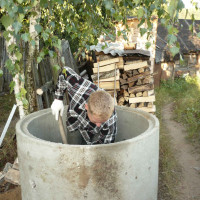 How to make rings for a cesspool of concrete or plastic
How to make rings for a cesspool of concrete or plastic 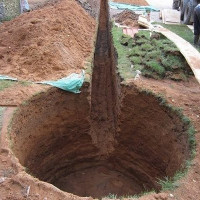 How a cesspool is constructed without a bottom: schemes and arrangement rules
How a cesspool is constructed without a bottom: schemes and arrangement rules  How a cesspool is constructed in a private house: a review of structures + rules for their arrangement
How a cesspool is constructed in a private house: a review of structures + rules for their arrangement 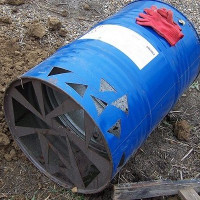 Barrel pit: step-by-step master-class on arrangement
Barrel pit: step-by-step master-class on arrangement 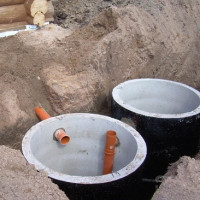 How a cesspool with overflow is arranged: schemes and construction technology
How a cesspool with overflow is arranged: schemes and construction technology 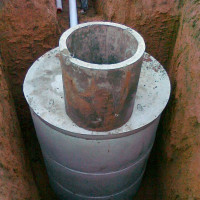 How to construct a cesspool of concrete rings: schemes + step-by-step guide
How to construct a cesspool of concrete rings: schemes + step-by-step guide  How much does it cost to connect gas to a private house: the price of organizing gas supply
How much does it cost to connect gas to a private house: the price of organizing gas supply  The best washing machines with dryer: model rating and customer tips
The best washing machines with dryer: model rating and customer tips  What is the color temperature of light and the nuances of choosing the temperature of the lamps to suit your needs
What is the color temperature of light and the nuances of choosing the temperature of the lamps to suit your needs  Replacement of a geyser in an apartment: replacement paperwork + basic norms and requirements
Replacement of a geyser in an apartment: replacement paperwork + basic norms and requirements
An excellent and reliable system, moreover, in this article everything is described in detail. At our summer cottage, we will definitely use the experience and useful recommendations received on this Internet resource. The main thing is to properly equip the cesspool so that there are no problems in the future. And knowing the specifics of the construction of the system, no problems with the arrangement will arise.
Once, before reading your material, I thought that the cesspool was just a dug hole. Now I plan to build a house, and I liked the idea with plastic tanks or rings. I am more inclined with a tank, for money, most likely, it should come out much more economically than rings. Yes, and delivery will cost less, and even under its own power you can bring. There are no price comparisons for such a pleasure?
If we talk about a full cesspool not only for “gray”, but also for “brown” drains, then the option of rubber tires is simply disrespect for oneself, neighbors and the environment. Tightness of such a design is almost impossible to achieve, it will negatively affect the soil, possibly falling into groundwater. In general, I think that this is an option only for “gray” domestic wastewater.